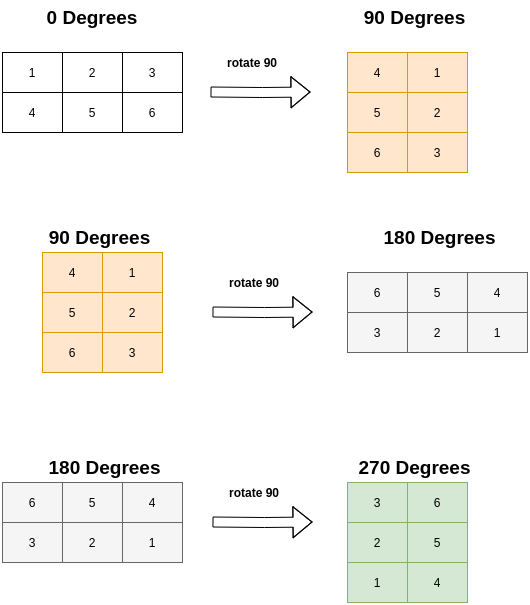Rotate Array 270 Degrees
23 Jan 2021 - Hadron DaVinci

Problem
Given an array, rotate it 270 degrees.
Example
given
A = [
[1, 2, 3],
[4, 5, 6]
]
rot270(A)
produces the following:
[
[3, 6],
[2, 5],
[1, 4]
]
Steps

Observations
- Rotating 270 degrees is the same as rotating forward 90 degrees three times (or backwards 90 degree once)
- This is useful since we can express rot270(A) in terms of rot90(A)
- This is useful since we can express rot270(A) in terms of rot90(A)
- The transpose(A) is the same as rot90(A) but with the rows reversed
Implications
- There is a relationship between rot90(A) and A
- this can probably be described by some mapping function
Methods
Method 1
Method 1 Summary
This approach is based on Observation 2.
- Create Method of rotating array 90 degrees
- Determine the transpose of arr
- Reverse each row in transpose
- Return result
- Rotate 90 three times
Complexity
TC: N
SC: N
Method 1 Solution
def rot90(arr: list) -> list: transpose = zip(*arr) transpose_with_reversed_rows = [ row[::-1] for row in transpose ] return transpose_with_reversed_rows
# Try Code if __name__ == "__main__": A = [ [1, 2, 3], [4, 5, 6], ]for _ in range(3): A = rot90(A)print(A)
Method 2
Method 2 Summary
This approach is based on Implication1.
The relationship between rot90(A) and A can be described by the following:
Given
- let j represent the row index in rot90(A)
- let i represent the column index in rot90(A)
- let r represent the row count in the A
- let c represent the column count in the A
- let rj = r - 1
- this is the largest row index possible in A
Then
A_rotated90[j][i] = A[rj - i][j]
- for 0 < j < c
- for 0 < i < r
Exact Steps
- Create Method of rotating array 90 degrees
- Double loop through columns and rows in A
- Populate rotated array with relationship:
A_rotated90[j][i] = A[rj - i][j]- Return result
- Rotate 90 three times
Complexity
TC: N
SC: N
Method 2 Solution
def rot90(arr: list): r = len(arr) c = len(arr[0]) rj = r - 1 output = [[0] * r for _ in range(c)]for j in range(c): for i in range(r): output[j][i] = arr[rj - i][j] return output
# Try Code if __name__ == "__main__": A = [ [1, 2, 3], [4, 5, 6], ]for _ in range(3): A = rot90(A)print(A)